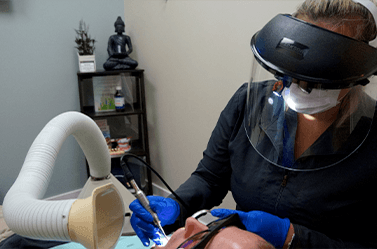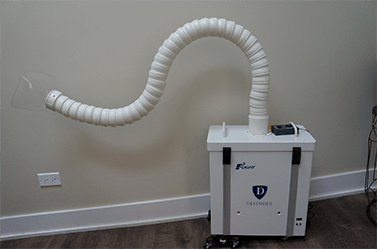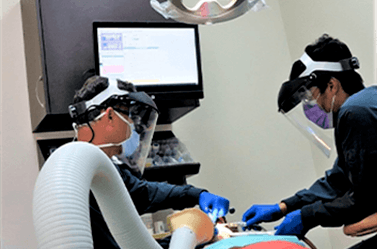Trine Dental Far UV-C Press Release
Dr. Christopher Pavletic and our team understand that our patients may be worried about the spread of infection in a dental office. We have invested in cutting-edge technology designed to keep our office spaces cleaner and reduce the amount of aerosols, bacteria and viruses on surfaces and in the air by 99.9%. Click the buttons below to learn more about the technology we are using to keep you protected during your visit with our team!
Sanitation Lights

Mini Air Scrubber

Evacuation

Krypton™ Far UV-C light disinfection treatment completely destroys bacteria and viruses.
Krypton™ light completely eradicates single-cell organisms, with less energy and with no photoreactivation.
Krypton™ light primarily kills microbes by resonating with the proteins in the microbe’s outer membrane causing it to fail, rather than just the DNA itself.

Infection control, state-of-the art technology and our patients’ health have always been top priorities at Trine Dental Group. Dr. Pavletic strives to be ahead of the curve in providing such services. He purchased his first CEREC CAD/CAM digital dentistry system (same-day crowns) in 2006 and has been performing safe amalgam (mercury) filling removals for well over a decade. We also feature incorporated lasers (NV microlasers) for periodontal issues, low radiation X-rays (Nomad), free oral cancer screenings (VELscope®) and options for effective, all-natural rinses and toothpaste.
With the onset of COVID-19, we did the research and are now one of the first in Chicagoland to utilize the cutting-edge technology of Krypton™ Far UV-C Disinfection Lights in our dental practice. Krypton™Far UV-C lights are the world’s first and only fully autonomous, safe, and continuous disinfection solution for any known virus, bacteria, or fungi in occupied spaces. Hospital-grade air and surface disinfection are proven to reduce viral loads up to 99.9%.
Krypton™ Far UV-C Lighting is much safer for animals/humans

Although Kypton™ 222-nm light can penetrate and kill bacteria such as MRSA, it is unable to penetrate to the nucleus of human cells.
UV-C from conventional 254 nm lamps can penetrate and damage sensitive cells in the epidermis.
Credit: Dr. David Brenner, Columbia University Medical Center

SAFE – EFFECTIVE – PRACTICAL
Krypton™ light (222nm wavelength) can autonomously and continuously disinfect any known virus, bacteria or fungi in occupied spaces, which is essential for containing and mitigating the emerging threat of the coronavirus and similar outbreaks where potentially infected human carriers in occupied locations are often not distinguishable from the non-carriers.
Krypton™ lamps (operating at 222nm) are superior to existing UV-C sanitation systems (typically operating at 254nm) in occupied spaces for a very simple reason: Legacy UV-C sanitation systems are ineffective at disinfecting surfaces and air in occupied spaces because the kill mechanism allows pathogens to be reactivated by UV-A light, which includes sunlight, fluorescent lights and other light sources after sanitation.
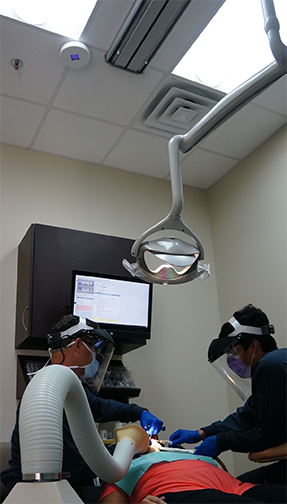
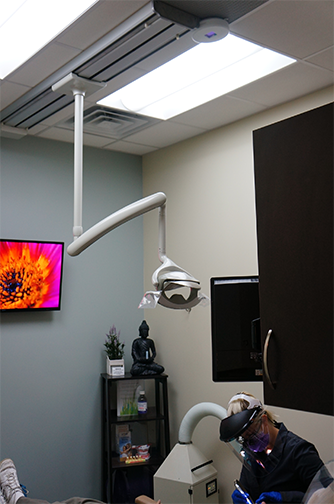
Traditional UV-C disinfecting systems use mercury lamps, and more recently LEDs, to generate UV light at wavelength between 254-260nm. While generally effective, UV-C lights come with two major downsides: First, they are not safe for human exposure, as they pose a carcinogenic safety risk for the skin and eyes. As a result, they are often used when the spaces are not occupied or are used in HVAC systems to treat the air that recirculates through the venting. While this effectively treats the air that does recirculate through the HVAC system, it is unknown how much of the air within a space is recirculated and does nothing to treat the surfaces within a space leaving considerable exposure risk. Second, when organisms are inactivated by 254nm UV-C, a significant amount may be reactivated by exposure to UV-A or visible blue light found in sunlight, fluorescent lights and other light sources after sanitation within a day or even hours. In contrast, Krypton™ lighting emits UV light at the “far” end of the UV spectrum (200-230nm), using inert krypton gas to emit 222nm UV light with the addition of trace amounts of chloride, and 207nm UV light with the addition of bromide. These Far UV wavelengths are safe for human exposure because they do not penetrate the skin or eyes. Additionally, pathogens do not reactivate following exposure to far UV, due to a different permanent kill mechanism than that of 254nm light. Krypton light primarily kills microbes by resonating with the proteins in the microbe’s outer membrane, causing it to fail. Far UV can autonomously and continuously disinfect viruses, bacteria and fungi in occupied spaces, which is essential for containing and mitigating the emerging threat of the coronavirus and similar outbreaks in which potentially infected human carriers in heavily occupied locations are often not distinguishable from the non-carriers. Along with effective diagnostics, vaccines, and therapies, elimination of pathogens in occupied spaces is a critical element of disease eradication. Far UV technology is an essential addition to existing sanitation practices, as part of a multi-pronged approach to prevent the spread of existing and emerging infectious disease.
To date, we are unaware of any bacteria, viruses, or fungi that far UV light has not successfully killed. Data are available specifically assessing 222nm far UV light against organisms such as E. coli 0157:H7, Yersinia enterolytica, and methicillin resistant Staphylococcus aureus (MRSA), influenza A (H1N1), adenovirus and coronaviruses. It should address the most common illnesses caused by rhinovirus (the common cold), norovirus (flu), and the bacteria responsible for the most common foodborne illnesses such as Salmonella, Listeria, Shigella and Campylobacter, in addition to eradicating more dangerous microorganisms including Ebola, MERS, SARS, coronaviruses and all chemical or antibiotic resistant microbes (MRSA, C Diff).
At present, at least 5 academic institutions are assessing the efficacy of 222nm UV light against COVID-19, and we will share these results as soon as they become publicly available. The only reason it has taken this long is that COVID-19 specific testing requires Bio-Safety Level 3 labs, which are less common and at present most research institutions have been closed due to the pandemic. That said, based on the significant efficacy of 222nm UV light against other coronaviruses such as feline enteric coronavirus, HCoV-229E and HCoV-OC43, there is no reason to believe that 222nm UV light will not be effective in killing COVID-19. Coronaviruses are actually among the easiest of pathogens for Krypton disinfection. UPDATE: As expected, 222nm Krypton lighting has been proven to be just as effective against the COVID-19 specific strain and multiple labs are in the process of publishing the new data now (see Columbia release in #4 below).
There is ample publicly available peer-reviewed clinical data available. A few links are supplied below from some of our strategic partners and other academic and industry-leading participants as well as some information from the CDC regarding the recent coronavirus pandemic.
- Effectiveness of 222-nm ultraviolet light on disinfecting SARS-CoV-2 surface contamination
- Far-UVC Light Safely Kills Airborne Coronaviruses
- Ushio Inc. and Kobe University have achieved the world’s first successful reduction of bacteria using ultraviolet irradiation that is harmless to normal human skin
- Germicidal Efficacy and Mammalian Skin Safety of 222-nm UV Light
- Far-UVC light: A new tool to control the spread of airborne-mediated microbial diseases
- Long-term Effects of 222-nm ultraviolet radiation C Sterilizing Lamps onMice Susceptible to Ultraviolet Radiation
- Aerosol and Surface Stability of SARS-CoV-2 as Compared with SARS-CoV-1
- Narrow-Spectrum UV Light May Reduce Surgical Infections
- 207-nm UV Light—A Promising Tool for Safe Low-Cost Reduction of Surgical Site Infections.
- The Airplane Bathroom That Cleans Itself
- CDC Covid-19 Page
- Clinical characteristics and outcomes of patients undergoing surgeries during the incubation period of COVID-19 infection
3-STAGE FILTRATION TECHNOLOGY ADVANCED
Featuring a powerful 1/2 HP external rotor induction motor, this 3-stage commercial purification system produces 550 CFM with less than a 3.0 amp draw. Developed to restore indoor air quality at a variety of job sites, the X-2480A with HEPA filter effectively removes contaminants such as bacteria, allergens, mold, and sub-micron sized dust with its advanced 3-stage filtration technology. The 1st stage washable and reusable nylon mesh filter works to extend the life of the primary filters. The 2nd stage pleated media filter removes additional impurities, while the 3rd stage featuring a true HEPA filter captures 0.3-sized (and larger) microns at a 99.97% rate.
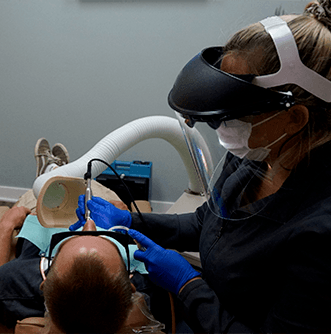
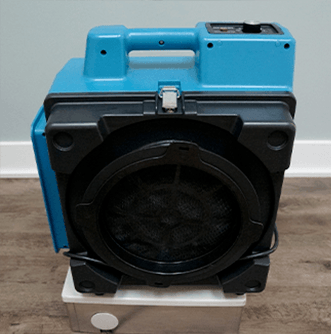
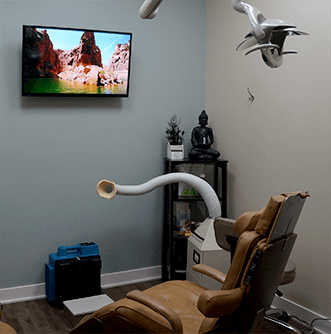
State of the art Aerosol Evacuator systems
Our Aerosol evacuator systems, such as The Defender is a high-power suction system that evacuates viruses, bacteria, dust, and aerosols through a three-stage HEPA filtration system that is said to eliminate 99.7 percent of all particulate matter. This matter is then filtered through UV-C disinfection before being exhausted out. The system provides protection for the staff, doctors and patients alike.
